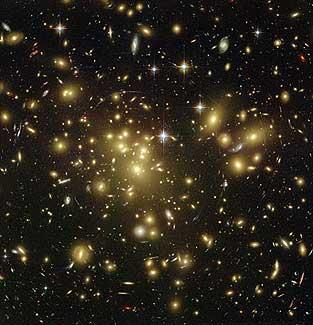The Advanced Camera for Surveys aboard NASA's Hubble Space Telescope took this photo using a 13 hour exposure time and a natural "zoom lens" in space to boost its view of the distant universe. This lens consisted of the gravity of the trillion stars of one of the most massive galaxy clusters known, called Abell 1689, which is located 2.2 billion light-years away and acts as a "gravitational lens" which bends and magnifies the light of galaxies located far behind it.
Hubble astronomers speculate that some of the faintest objects in the picture are probably over 13 billion light-years away.
The picture is an exquisite demonstration of Albert Einstein's prediction that gravity warps space and therefore distorts a beam of light, like a rippled shower curtain. Though Einstein realized this effect would happen in space, he thought it could never be observed from Earth. Though individual stars lens background light, the deflection was too small to ever be seen from Earth.
For more details check out:
article about background picture on our home web page
You can find Hubble pictures and information at:
Hubble pictures and information

More: Hubble and Keck Team Up to Find Farthest Known Galaxy in Universe
Free JavaScripts provided
by The JavaScript Source

